

Getting Permission - Copyright Crash Course - LibGuides at University of Texas at Austin. Know the ownership drill In the good old days, copyright owners were prominently noted in the copyright notice that used to be required.
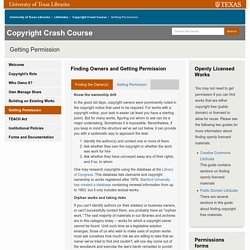
For works with a copyright notice, your task is easier (at least you have a starting point). But for many works, figuring out whom to ask can be a major undertaking. Sometimes it is impossible. Nevertheless, if you keep in mind the structure we've set out below, it can provide you with a systematic way to approach the task: Section 108 Spinner. Other Criteria The copy becomes the property of the user and the library has no reason to believe that it will be used for anything other than research, scholarship and private study purposes A warning of copyright is placed where orders are accepted The cop[ies] are not made for direct or indirect commercial advantage A copyright notice is included on the cop[ies] The library or archives is open to the public or to unaffiliated specialized researchers Any requests for the same material are isolated and unrelated Notes: * This section does not apply to musical, pictorial, graphic or audiovisual works/motion pictures.
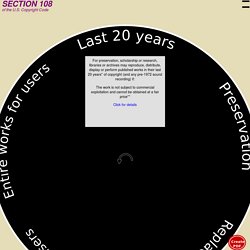
Advocacy, Legislation & Issues. A Copyright-Friendly Toolkit. However fabulous Creative Commons and Public Domain content may be, sometimes you really need to use copyrighted material. Say you plan to comment on popular media or current events. For instance, you may be planning to critique the portrayal of Native Americans in commercial films. You are going to want to “quote” some commercial films like Pocahontas, Lone Ranger, and Dances with Wolves. If you are reviewing a book, you may want to share its cover art. U.S. Copyright Office. Public Domain Frequently Asked Questions. What is the public domain?

Public domain works are not restricted by copyright and do not require a license or fee to use. Public domain status allows the user unrestricted access and unlimited creativity! There are three main categories of public domain works: Works that automatically enter the public domain upon creation, because they are not copyrightable: Titles, names, short phrases and slogans, familiar symbols, numbersIdeas and facts (e.g., the date of the Gettysburg Address)Processes and systemsGovernment works and documentsWorks that have been assigned to the public domain by their creatorsWorks that have entered the public domain because the copyright on them has expired.
Copyright Frequently Asked Questions. The Congress shall have Power To… promote the Progress of Science and useful Arts, by securing for limited Times to Authors and Inventors the exclusive Right to their respective Writings and Discoveries — United States Constitution, Article 1, Section 8 What is copyright? Managing Copyright for Librarians. Managing copyright in a building is as much about managing people as it is about managing things.
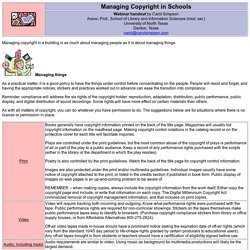
Managing things As a practical matter, it is a good policy to have the things under control before concentrating on the people. People will resist and forget, and having the appropriate notices, stickers and practices worked out in advance can ease the transition into compliance. Reminder: compliance will address the six rights of the copyright holder: reproduction, adaptation, distribution, public performance, public display, and digital distribution of sound recordings. The Right to Display Public Domain Images - English History. Results on ReadWriteThink. Find content from Thinkfinity Partners using a visual bookmarking and sharing tool.
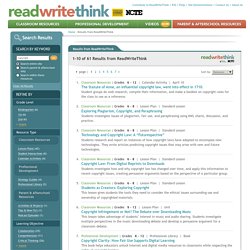
More Your students can save their work with Student Interactives. More. Only2Clicks: Copyright Friendly Portals (Valenza) Copyright Guide for Music Librarians / Resources. Guidelines for Educational Uses of Music The following guidelines were developed and approved in April 1976 by the Music Publishers' Association of the United States, Inc., the National Music Publishers' Association, Inc., the Music Teachers National Association, the Music Educators National Conference, the National Association of Schools of Music, and the Ad Hoc Committee on Copyright Law Revision.
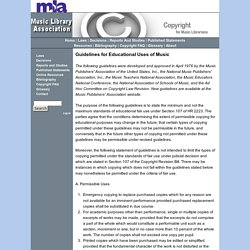
New guidelines are available at the Music Publishers' Association website. The purpose of the following guidelines is to state the minimum and not the maximum standards of educational fair use under Section 107 of HR 2223. The parties agree that the conditions determining the extent of permissible copying for educational purposes may change in the future; that certain types of copying permitted under these guidelines may not be permissible in the future, and conversely that in the future other types of copying not permitted under these guidelines may be permissible under revised guidelines. Taking the Mystery Out of Copyright. Skip navigation Library of Congress Teachers Suggestions enabled.
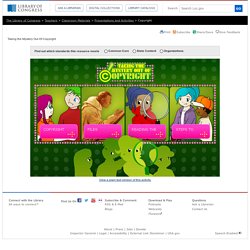
The Library of Congress > Teachers > Classroom Materials > Presentations and Activities > Copyright. Copyright Advisory Network - Copyright Advisory Network. SLIDE SHARE: Copyright Clarity: Using Copyrighted Materials for Digital Learning. The Best Ways to Be Sure You're Legally Using Online Photos. Copyright & Copyleft Wiki. Copyright and Creative Commons Explained by Common Craft. Copyright Kids!
Copyright MOOC videos. MUSIC VIDEO: Copyright? What's Copyright? Educational Technology and Mobile Learning: copyright resources. August 12, 2014 Now that the new school year is about to start, it would be great to devote a session with your students where you can talk to them about issues related to copyright and proper use of digital artifacts from the net.
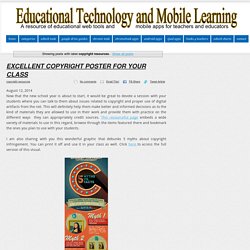
This will definitely help them make better and informed decisions as to the kind of materials they are allowed to use in their work and provide them with practice on the different ways they can appropriately credit sources. This resourceful page embeds a wide variety of materials to use in this regard, browse through the items featured there and bookmark the ones you plan to use with your students. Copyright with Cyberbee. An Educator's Guide to Intellectual Property. FindingCC0images- Symbaloo Gallery. A celebration of CC0 images! No rights reserved. Free To Use and Share: Resources To Help Teach Kids (and Adults!) About Copyright and Creative Commons. I've gotten a few requests lately for resources on how to teach kids (and adults!)
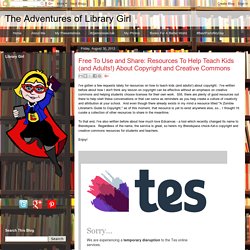
About copyright. I've written before about how I don't think any lesson on copyright can be effective without an emphasis on creative commons and helping students choose licenses for their own work. Still, there are plenty of good resources out there to help start these conversations or that can serve as reminders as you help create a culture of creativity and attribution at your school. From Cop to Counselor. Most of these columns, updated and edited, can be found in my book School Libraries Head for the Edge.
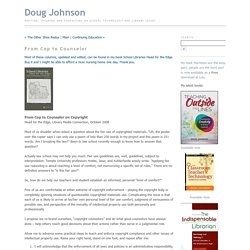
Buy it and I might be able to afford a nicer nursing home one day. Thank you. Lesson in Action: Copyrights and Wrongs. Permission Request Template. Reproduction of Copyrighted Works by Educators and Librarians. The Ultimate Copyright Guide for Students: Basics You Should Know. The Internet has brought the issue of copyright to the forefront like nothing else in history. The ease and speed with which people can share digital information has also made it very easy to commit copyright infringement, intentionally or not. In this guide, we cover copyright, plagarism, and the DMCA with specific references and insights for students. As a student, you have terabytes of data available literally at your fingertips, which makes project research and paper writing easier than they've ever been before.
But it also means you must be more aware of copyright rules in order to avoid violating them. U.S. Copyright Basics. Copyright and Primary Sources. How do I use the Restriction Statements that accompany the American Memory collections? The Library of Congress assesses materials for legal considerations prior to placing items online (see legal assessment). The Restriction Statement that accompanies each American Memory collection provides known information regarding ownership of materials in the collection. If known, we include contacts for permission. In some cases the Restriction Statement will indicate that material in a particular collection may be used freely; in other cases the Restriction Statement may only be a starting point for your inquiry. Lesson in Action: Copyrights and Wrongs. Copyright Law, Intellectual Property, & Trademark Law.
Copyright-CopyWrong. The Educators' Lean and Mean No FAT Guide to Fair Use By Hall Davidson You can't afford to ignore the law, but neither can you afford to overlook the needs of your students. Basics - Copyright Clearance Center. FAQs About Copyright. Copyright for Librarians.